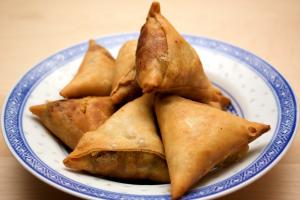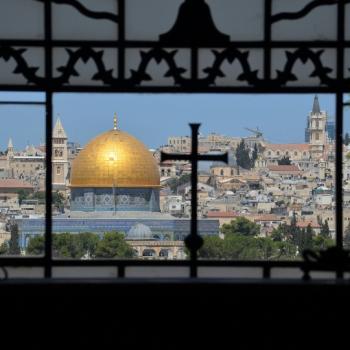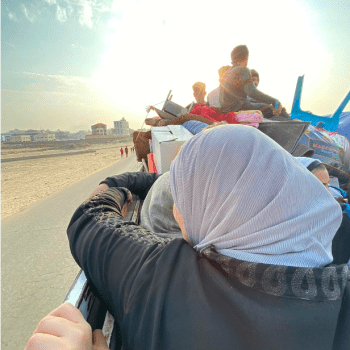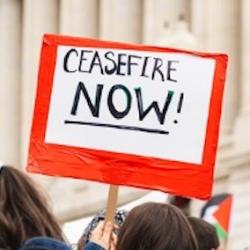We’ve talked about the jihad (struggle) part of Ramadan, the long hours of fasting that can challenge, build character, and bring one closer to God. Fasting can also make one cranky or sleepy or lethargic – but when the prayer call sounds, all those negatives go by the wayside and the digestive juices flow once more. Because now it’s chow time!
I think of iftar (the meal that breaks the fast) as Thanksgiving Day. More precisely, the 30 iftars during the month of Ramadan are like 30 Thanksgiving Days in a row – at least that’s been my experience in Muslim culture.
As I’ve mentioned elsewhere, the fast is traditionally broken with dates and water. Many Muslims will then pray before coming back for soup (I’ll share my mother-in-law’s Quaker Soup recipe before the end of the series – it’s delicious!) and all manner of goodies. When everyone is stuffed, it’s time for coffee or tea, perhaps some dessert, and then possibly a trip to the local mosque for tarawiyyeh (reading of a portion of the Qur’an). The rest of the night is up for grabs.
Many people I knew in Saudi Arabia would stay up all night, snacking and watching TV. There are some great series especially produced for Ramadan – the one we always enjoyed was called Tash ma Tash (named after a game of guessing whether a bottle of Pepsi will bubble over). Before dawn, the leftovers may come out of the fridge for sahoor (the “last supper” before the fast begins again at sunrise).
Of course, this month-long routine only works if you can sleep half the day – it works pretty well in Saudi, where many stores stay open till 2 or 3 am (restaurants sometimes till sunrise), but are closed for the morning, and where schools and businesses have drastically shortened hours. But in places where no such accommodations are available, you sleep when you can (here in the US, my husband sometimes catches an hour after work/before iftar, and then a few hours befor sahoor – and catches up over each weekend).

One of our favorite Ramadan specialties is called samboosek. In some places it’s called samosa. Doesn’t it look yummy? Traditionally it contains spiced minced or ground beef and onions, but I like trying different fillings throughout the month. (Here’s a recipe for making samboosek with US-available ingredients.)
My mother-in-law, an excellent cook, stayed with us for a couple of Ramadans, and she literally spent the whole day in the kitchen, preparing everybody’s favorite dishes. When it was time to eat, we made many trips from the kitchen to the dining area with platters of wonderful Palestinian food.
The Arab culture places a high value on hospitality, and everyone tries to provide the best they can during Ramadan.
I often saw, as we drove through Jeddah near iftar time, restaurants setting up serving tables on the sidewalk – mountains of free food for anyone who wanted some. Part of Ramadan is connecting with the poor in the community and providing for them as you are able. (It’s not unlike Christmas, when we collect toys and mittens for needy children.)
Sometimes too, there were people standing at intersections with boxes – little packages of dates and bottles of water to hand out to people as they drove by. That way, if you’re not going to be home in time, you can break your fast on the road.
Because of my husband’s work, we got free tickets to some of the most elaborate Ramadan iftar buffets in Jeddah. They were pretty ridiculous, with turkey-carving servers in tall chef hats, tuxedo-clad waiters pouring sparkling apple juice (there is officially no alcohol in Saudi Arabia).
The quantity of leftover food, scattered on tables and the floor at the end of the evening was, of course, shameful. Equally shameful was really the quantity of food in our bellies – much more than we needed. We literally could not stay awake for the drive home without stopping for coffee (and we were relatively light eaters).
Ramadan 2.0?
Lately, my husband has been telling me about a whole new progressive teaching on Ramadan (at least, new to him): they say that Ramadan as it is generally practiced today isn’t working. After 1400 years of Islam – 1400 months of Ramadan philanthropy – poverty and hunger are still rampant, with pockets of extravagant wealth sprinkled in between.
True empathy with the poor, and true introspection and drawing near to God – the hallmarks of Ramadan – would have ended this disparity centuries ago. These teachers explain that the point is not for the poor to get more handouts from the rich. The point is that the rich should use some of their wealth to create equity and opportunity, and eventually, a level playing field.
They propose that, instead of fasting, any Muslim who can afford to should contribute to a charity set up specifically for this purpose – say, $5 a day for the 30 days of Ramadan. There are something like 1.8 billion Muslims in the world – if even 10% of them gave $150 instead of fasting (or how about in addition to fasting?), that’s $27 billion in one month.
The 10 wealthiest Muslims in the world have a combined net worth of nearly $100 billion. They could each give $1 million a day in Ramadan and not even feel it – another $300 million. 3 of the 10 wealthiest countries in the world are Muslim – they could easily scrape together $3 billion more (btw 3 of the 10 poorest countries are also Muslim).
That’s over $30 billion in a month. If that money is spent wisely (for example, not on weapons), much of the Muslim world could begin to rise out of poverty in a few years.
Christianity needs a reboot too
Needless to say, this is not just a Muslim problem – not by a longshot. America is a place of great wealth, and 200 million Christians, but we too are awash in poverty. We too have been scandalously bad stewards of our wealth.
We have allowed, or even commanded, our elected officials to make the poor poorer, to withhold health care and other human rights from them, and we have “passed by on the other side” of our own neighbors – all while proclaiming to love Jesus who instructed us to help those in need.
Many, many of us have way, way more than we need. It’s not just that we don’t give enough to charity. We don’t want the poor to be helped out of poverty, do we?
And we know exactly how Jesus feels about that.
OTHER RELATED POSTS:
What if I don’t actually “need” my stimulus check?
Gnats, camels, and Christian indifference
Ramadan for Christians: what do our holy books really say?
“When I was hungry, you handcuffed me” – see Jesus in Palestinian children
FEATURED IMAGE: “samosas” by penguincakes is licensed under CC BY-NC-SA 2.0

















